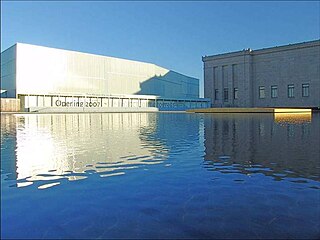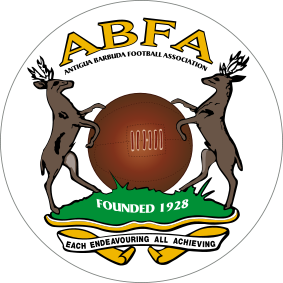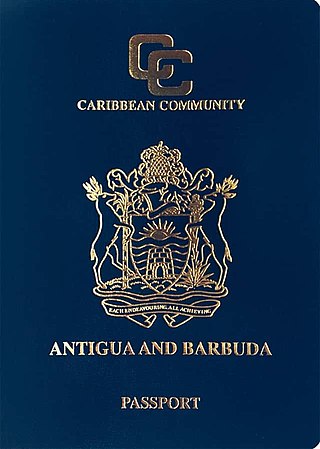Related Research Articles

Antigua and Barbuda is a sovereign island country in the West Indies. It lies at the conjuncture of the Caribbean Sea and the Atlantic Ocean in the Leeward Islands part of the Lesser Antilles.
The history of Antigua and Barbuda covers the period from the arrival of the Archaic peoples thousands of years ago to the present day. Prior to European colonization, the lands encompassing present-day Antigua and Barbuda were inhabited by three successive Amerindian societies. The island was claimed by England, who settled the islands in 1632. Under English/British control, the islands witnessed an influx of both Britons and African slaves migrate to the island. In 1981, the islands were granted independence as the modern state of Antigua and Barbuda.

Barbuda is an island located in the eastern Caribbean forming part of the twin-island state of Antigua and Barbuda as an autonomous entity. Barbuda is located approximately 30 miles (48 km) north of Antigua. The sole settlements on the island are Codrington and its surrounding localities. Barbuda is a flat island with the western portion being dominated by Codrington Lagoon, and the eastern portion being dominated by the Barbuda Highlands, with salty ponds and scrubland spread throughout the island. The climate is classified as tropical marine.

The national flag of Antigua and Barbuda was adopted on 27 February 1967 to mark the achievement of self-government. A competition to design the flag was held in which more than 600 local people entered. The winning design was put forth by nationally well-known artist and sculptor Sir Reginald Samuel.

The Nelson-Atkins Museum of Art is an art museum in Kansas City, Missouri, known for its encyclopedic collection of art from nearly every continent and culture, and especially for its extensive collection of Asian art.
The music of Antigua and Barbuda is largely African in character, and has only felt a limited influence from European styles due to the population of Antigua and Barbuda descending mostly from West Africans who were made slaves by Europeans.

The Antigua and Barbuda national football team is the national team of Antigua and Barbuda and is controlled by the Antigua and Barbuda Football Association, a member of the CONCACAF and the Caribbean Football Union (CFU). The team has never qualified for the FIFA World Cup or the CONCACAF Gold Cup.

Korean arts include traditions in calligraphy, music, painting and pottery, often marked by the use of natural forms, surface decoration and bold colors or sounds.

Antigua, also known as Waladli or Wadadli by the native population, is an island in the Lesser Antilles. It is one of the Leeward Islands in the Caribbean region and the most populous island of the country of Antigua and Barbuda. Antigua and Barbuda became an independent state within the Commonwealth of Nations on 1 November 1981.

The Sarjeant Gallery Te Whare o Rehua Whanganui at Pukenamu, Queen's Park Whanganui is currently closed for redevelopment. The temporary premises at Sarjeant on the Quay, 38 Taupo Quay currently house the Sarjeant Collection, and all exhibitions and events. The Sarjeant Gallery is a regional art museum with a collection of international and New Zealand art.

The following outline is provided as an overview of and introduction to Antigua and Barbuda:

Antiguan and Barbudan passports are issued to nationals of Antigua and Barbuda for international travel. The passport is a CARICOM passport as Antigua and Barbuda is a member of the Caribbean Community.

Education in Antigua and Barbuda is compulsory and free for children between the ages of 5 and 16 years. The system is modeled on the British educational system. The current Minister of Education, Sport & Creative Industries is Daryll Sylvester Matthew.

Antigua and Barbuda maintains diplomatic relations with the United States, Canada, the United Kingdom, and the People's Republic of China, as well as with many Latin American countries and neighbouring Eastern Caribbean states. It is a member of the United Nations, the Commonwealth of Nations, the Organization of American States, the Organisation of Eastern Caribbean States, the Bolivarian Alliance for the Americas, Petrocaribe and the Eastern Caribbean's Regional Security System (RSS).

Art pottery is a term for pottery with artistic aspirations, made in relatively small quantities, mostly between about 1870 and 1930. Typically, sets of the usual tableware items are excluded from the term; instead the objects produced are mostly decorative vessels such as vases, jugs, bowls and the like which are sold singly. The term originated in the later 19th century, and is usually used only for pottery produced from that period onwards. It tends to be used for ceramics produced in factory conditions, but in relatively small quantities, using skilled workers, with at the least close supervision by a designer or some sort of artistic director. Studio pottery is a step up, supposed to be produced in even smaller quantities, with the hands-on participation of an artist-potter, who often performs all or most of the production stages. But the use of both terms can be elastic. Ceramic art is often a much wider term, covering all pottery that comes within the scope of art history, but "ceramic artist" is often used for hands-on artist potters in studio pottery.
John Maltby was a distinguished English sculptor and studio potter.
Caribbean art refers to the visual as well as plastic arts originating from the islands of the Caribbean. Art in the Caribbean reflects thousands of years of habitation by Arawak, Kalinago, and other people of the Caribbean followed by waves of immigration, which included artists of European origins and subsequently by artists with heritage from countries all around the world. The nature of Caribbean art reflects these diverse origins, as artists have taken their traditions and adapted these influences to reflect the reality of their lives in the Caribbean.

Visitors to Antigua and Barbuda must obtain a visa from one of the Antigua and Barbuda diplomatic missions or in certain cases in United Kingdom diplomatic missions unless they come from one of the visa exempt countries.
Frank Walter, born Francis Archibald Wentworth Walter, was an Antiguan artist, sculptor, photographer, composer, writer, and philosopher. Always shy and reserved, he became a recluse in later life so that he could devote himself to the pursuit of art. Walter has achieved posthumous recognition as one of the Caribbean's most significant artists.
Heather Doram is an Antiguan artist, actor, activist and educator, who is the designer of Antigua & Barbuda's national costume. In 2002 she was awarded the Grand Cross of the Most Illustrious Order of Merit (Antigua) in recognition of her lifetime achievements.
References
- 1 2 "A' Design Award and Competition - Design Encyclopedia - History Of Art In Antigua And Barbuda". competition.adesignaward.com. Retrieved 2023-08-16.
- ↑ "Art Galleries". Discover Antigua Barbuda. Retrieved 2023-08-16.
- ↑ "Antigua and Barbuda Art Week". Visit Antigua & Barbuda. 2023-03-01. Retrieved 2023-08-16.
- ↑ "Antigua and Barbuda / Pressroom". www.antigua-barbuda.org. Retrieved 2023-08-16.